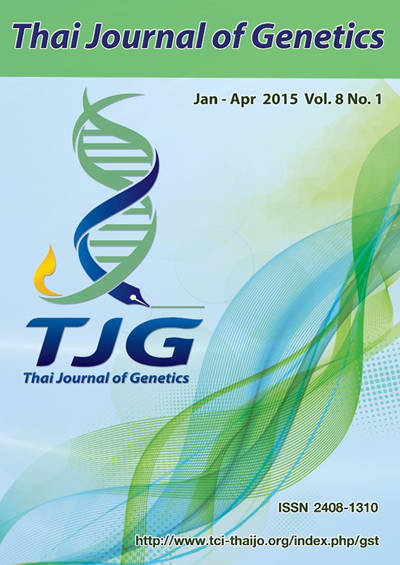ความหลากหลายทางพันธุกรรมของสบู่ดำ (Jatropha curcas L.) จากลักษณะทางสัณฐานวิทยา ลักษณะทางการเกษตร และเครื่องหมายดีเอ็นเอ (Genetic diversity of physic nut (Jatropha curcas L.) based on morpho-agronomic characters and DNA markers)
DOI:
https://doi.org/10.14456/tjg.2015.5Keywords:
สบู่ดำ, ความหลากหลายทางพันธุกรรม, การวิเคราะห์การจัดกลุ่ม, ลักษณะทางการเกษตร, เครื่องหมายดีเอ็นเอ, physic nut, genetic diversity, cluster analysis, agronomic characters, DNA markerAbstract
Genetic diversity and cluster analysis of 128 accessions of physic nut (Jatropha curcas L.) collected from various sources in Thailand and other countries were analyzed and compared using morphological characters, agronomic characters and DNA fingerprints developed by AFLP markers. The results revealed that all accessions of physic nut showed very low genetic diversity when evaluated by morphological characters and DNA fingerprints. Genetic variation was also assessed using agronomiccharacters. It was found that some agronomic characters showed high genetic variation whereas others exhibited low genetic variation. Cluster analysis of 128 accessions of physic nut using morphological characters was in accordance with that using DNA fingerprints. Physic nut was clustered into two groups; the first group consisted of 127 accessions while the second group comprised only one accession. However, the one accession was not the same when analyzed by different method. It was accession J23 with variegated leaves and young fruit in cluster analysis using morphological characters whilst it was J7 from USA having normal green leaves and young fruits in cluster analysis using DNA fingerprints. Principal component analysis (PCA) for clustering using agronomic characters could not classify physic nut into distinct groups following the cluster analysis using morphological characters and DNA fingerprints. However, PCA using agronomic characters could differentiate some accessions with specific and distinct characters. These accessions might be selected and used as germplasm for further improvement of physic nut with desirable characters.
จากการวิเคราะห์และเปรียบเทียบความหลากหลายทางพันธุกรรมและการจัดกลุ่มสบู่ดำ (Jatropha curcas L.) จำนวน 128 accession ที่รวบรวมจากแหล่งต่างๆ ทั้งภายในและต่างประเทศโดยอาศัยลักษณะทางสัณฐานวิทยาลักษณะทางการเกษตร และลายพิมพ์ดีเอ็นเอจากเครื่องหมาย AFLP พบว่า สบู่ดำทั้งหมดมีความหลากหลายทางพันธุกรรมต่ำมากเมื่อประเมินโดยอาศัยลักษณะทางสัณฐานวิทยาและลายพิมพ์ดีเอ็นเอ ส่วนการประเมินความแปรปรวนทางพันธุกรรมในลักษณะทางการเกษตรของสบู่ดำ พบว่าบางลักษณะมีความแปรปรวนทางพันธุกรรมสูง ในขณะที่บางลักษณะมีความแปรปรวนทางพันธุกรรมต่ำ การจัดกลุ่มสบู่ดำโดยอาศัยลักษณะทางสัณฐานวิทยาสอดคล้องกับการจัดกลุ่มโดยอาศัยลายพิมพ์ดีเอ็นเอ กล่าวคือสามารถจัดแบ่งสบู่ดำออกเป็น 2 กลุ่ม โดยกลุ่มที่ 1 ประกอบด้วยสบู่ดำส่วนใหญ่จำนวน 127 accession ส่วนกลุ่มที่ 2 ประกอบด้วยสบู่ดำเพียง 1 accession แต่มิใช่ accession เดียวกันโดยเป็นสบู่ดำ J23 ที่ใบและผลอ่อนมีสีเขียวสลับขาวในการจัดกลุ่มโดยอาศัยลักษณะทางสัณฐานวิทยา และเป็นสบู่ดำ J7 จากสหรัฐอเมริกาที่ใบและผลอ่อนมีสีเขียวปกติในการจัดกลุ่มโดยอาศัยลายพิมพ์ดีเอ็นเอ ส่วนการวิเคราะห์องค์ประกอบหลักเพื่อการจัดกลุ่มสบู่ดำโดยอาศัยลักษณะทางการเกษตร พบว่าไม่สามารถจัดแบ่งสบู่ดำออกเป็นกลุ่มได้อย่างชัดเจน เช่นเดียวกับการจัดกลุ่มโดยอาศัยลักษณะทางสัณฐานวิทยาและลายพิมพ์ดีเอ็นเอ อย่างไรก็ตามการวิเคราะห์องค์ประกอบหลักโดยอาศัยลักษณะทางการเกษตรสามารถแยกสบู่ดำบาง accession ที่มีลักษณะทางการเกษตรที่เฉพาะและโดดเด่นออกมาจากสบู่ดำส่วนใหญ่ที่มีลักษณะใกล้เคียงกัน ซึ่งช่วยให้นักปรับปรุงพันธุ์สามารถคัดเลือกสบู่ดำเหล่านี้ไปใช้ประโยชน์ในการพัฒนาพันธุ์สบู่ดำให้มีลักษณะตามที่ต้องการต่อไป
References
พีระศักดิ์ ศรีนิเวศน์ (2555) วิจัยสบู่ดำพันธุ์ใหม่เพิ่มน้ำมันเป็น 2 เท่า. E-cite Thaipost, http://www.thaipost.net/x-cite/ (17 มกราคม 2555).
พัชรินทร์ ตัญญะ สนธิชัย จันทร์เปรม สมบัติ ชิณะวงศ์ พีระศักดิ์ ศรีนิเวศน์ (2551) ความหลากหลายทางพันธุกรรม ของสายพันธุ์สบู่ดำในเอเชียจากการประเมินโดยใช้เครื่องหมายโมเลกุลแบบ RAPD. ว วิชาการเกษตร 26: 36–47.
ระพีพันธุ์ ภาสบุตร สุขสันต์ สุทธิผลไพบูลย์ (2525) การใช้น้ำมันสบู่ดำเดินเครื่องยนต์ดีเซล. ใน: ผลการวิจัยค้นคว้าการใช้น้ำมันสบู่ดำเป็นพลังงานทดแทนในเครื่องยนต์ดีเซล. กองเกษตรเคมีและกองเกษตรวิศวกรรม กรมวิชาการเกษตร, กรุงเทพฯ, น 11–42.
ศิริศักดิ์ สุนทรยาตร วิภา หงษ์ตระกูล นิตย์ศรี แสงเดือน สุรินทร์ ปิยะโชคณากุล แอนนา สายมณีรัตน์ ประภา ศรีพิจิตต์ วิเชียร กีรตินิจกาล เพ็ญจิตร ศรีนพคุณ (2550) การศึกษาลายพิมพ์ดีเอ็นเอในสบู่ดำโดยเทคนิคเอเอฟแอลพี, การประชุมวิชาการสบู่ดำแห่งชาติครั้งที่ 1, 29–30 พฤษภาคม 2550. สถาบันค้นคว้าและพัฒนาผลิตภัณฑ์อาหาร มหาวิทยาลัย เกษตรศาสตร์ กรุงเทพฯ น. 141–148.
ศิริศักดิ์ สุนทรยาตร ประภา ศรีพิจิตต์ วิภา หงษ์ตระกูล รังสฤษฏ์ กาวีต๊ะ (2555) การศึกษาความหลากหลายทางพันธุกรรมของสบู่ดำ (Jatropha curcas L.) โดยอาศัยลักษณะทางสัณฐานวิทยาและลักษณะทางการเกษตร. ว วิทย กษ 43: 267–278.
Acquaah G (2007) Principles of Plant Genetics and Breeding. Blackwell Publishing, Malden.
Basha SD, Sujatha M (2007) Inter and Intra-population variability of Jatropha curcas (L.) characterized by RAPD and ISSR markers and development of population-specific SCAR markers. Euphytica 156: 375–386.
Caldwell J, Teagarden K (2010) What caused the ghostly leaves? inquiry-based investigation of the genetics and molecular biology of corn albinism. In: Tested Studies for Laboratory Teaching, Proceedings of The 31st Workshop/Conference of The Association for Biology Laboratory Education (ABLE), Oklahoma, pp 50–65.
Doyle JJ, Doyle J (1990) Isolation of plant DNA from fresh tissue. Focus 12: 13–15.
Pamidiamarri DVNS, Pandya N, Reddy MP, Radhakrishnan T (2010) Comparative study of interspecific genetic divergence and phylogenetic analysis of genus Jatropha by RAPD and AFLP. Mol Biol Rep 36: 901–907.
Prakash AR, Patolia JS, Chikara J, Boricha GN (2007) Flower biology and flowering behavior of Jatropha curcas. In: Exert seminar on Jatropha curcas L. fact foundation, Wageningen, pp 26–28.
Rohlf FJ (2005) NTSYS-pc: Numerical taxonomy and multivariate analysis system version 2.2 Exeter Publications, New York.
Shen J, Jia X, Ni H, Sun P, Niu S, Chen X (2010) AFLP analysis of genetic diversity of Jatropha curcas grown in Hainan, China. Trees 24: 455–462.
Sokal RR, Sneath PH (1963) Principles of numerical taxonomy. Freeman, San Francisco.
Subramanian KA, Singal SK, Sexena M, Singhal S (2005) Utilization of liquid biofuels in automotive diesel engines: an Indian perspective. Biomass Bioener 29: 65–72.
Tanya P, Taeprayoon P, Hadkam Y, Srinives P (2011) Genetic diversity among Jatropha and Jatropha-related species based on ISSR markers. Plant Mol Biol Rep 29: 252–264.
Vos P, Hogers R, Bleeker M, Reijans M, Van de Lee T, Hornes M, Frijters A, Pot J, Peleman J, Kuiper M, Zabean M (1995) AFLP: A new technique for DNA fingerprinting. Nuc Acid Res 23: 4407–4414.


